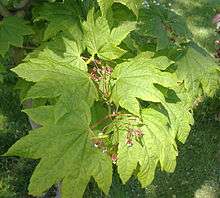Acer circinatum
| Vine maple | |
|---|---|
 | |
| Vine maple leaves and flowers | |
| Scientific classification | |
| Kingdom: | Plantae |
| (unranked): | Angiosperms |
| (unranked): | Eudicots |
| (unranked): | Rosids |
| Order: | Sapindales |
| Family: | Sapindaceae[1] |
| Genus: | Acer |
| Species: | A. circinatum |
| Binomial name | |
| Acer circinatum Pursh 1813 | |
 | |
| Natural range | |
| Synonyms[2] | |
| |
Acer circinatum (vine maple) is a species of maple native to western North America, from southwest British Columbia to northern California, usually within 300 kilometres (190 mi) of the Pacific Ocean coast, found along the Columbia Gorge and Coastal Forest.[3][4] It belongs to the Palmatum group of maple trees native to East Asia with its closest relatives being the Acer japonicum (Fullmoon Maple) and Acer pseudosieboldianum (Korean Maple). It can be difficult to distinguish from these species in cultivation. It is the only member of the Palmatum group that resides outside of Asia.
It most commonly grows as a large shrub growing to around 5 to 8 metres (16 to 26 ft) tall, but it will occasionally form a small to medium-sized tree, exceptionally to 18 metres (59 ft) tall. The shoots are slender and hairless. It typically grows in the under story below much taller forest trees, but can sometimes be found in open ground, and occurs at altitudes from sea level up to 1,500 metres (4,900 ft).[3][4]

The leaves are opposite, and palmately lobed with 7 to 11 lobes, almost circular in outline, 3 to 14 centimetres (1.2 to 5.5 in) long and broad, and thinly hairy on the underside; the lobes are pointed and with coarsely toothed margins. The leaves turn bright yellow to orange-red in fall. The flowers are small, 6 to 9 millimetres (0.24 to 0.35 in) in diameter, with a dark red calyx and five short greenish-yellow petals; they are produced in open corymbs of 4 to 20 together in spring. The fruit is a two-seeded samara, each seed 8 to 10 millimetres (0.31 to 0.39 in) in diameter, with a lateral wing 2 to 4 centimetres (0.79 to 1.57 in) long.[3][4][5]
Vine maple trees can bend over easily. Sometimes, this can cause the top of the tree to grow into the ground and send out a new root system, creating a natural arch.
It is occasionally cultivated outside its native range as an ornamental tree, from Juneau, Alaska[6] and Ottawa, Ontario[7] to Huntsville, Alabama,[8] and also in northwestern Europe.[9]
References
- ↑ Stevens, P. F. (2001 onwards). Angiosperm Phylogeny Website. Version 9, June 2008 [and more or less continuously updated since]. http://www.mobot.org/MOBOT/research/APweb/.
- ↑ The Plant List, Acer circinatum Pursh
- 1 2 3 Plants of British Columbia: Acer circinatum
- 1 2 3 Jepson Flora: Acer circinatum
- ↑ Ashley, A. & Ashley, P. (1990). The Canadian Plant Sourcebook. Cheriton Graphics, Ottawa, Canada.
- ↑ Downtown Juneau Tree Guide
- ↑ Buckley, A. R. (1980). Trees and Shrubs of the Dominion Arboretum. Research Branch, Agriculture Canada, Ottawa.
- ↑ University of Alabama, Huntsville: Oregon Vine Maple at UAH Arboretum Archived February 24, 2007, at the Wayback Machine.
- ↑ Rushforth, K. (1999). Trees of Britain and Europe. Collins ISBN 0-00-220013-9.
External links
| Wikimedia Commons has media related to: |